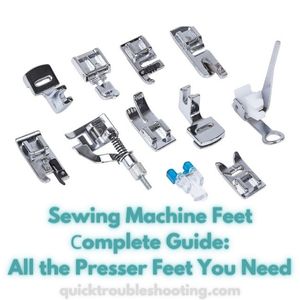Sewing Machine Feet Сomplete Guide: All the Presser Feet You Need
Unlock the full potential of your sewing machine with this comprehensive guide to sewing machine feet. Seamstresses often wonder, “What Presser feet do I need for my sewing machine?” This guide provides a clear answer, presenting essential presser feet to enhance your sewing experience. Whether you’re a beginner or an experienced sewer, discover the key feet that make your sewing faster, more accurate, and overall easier.
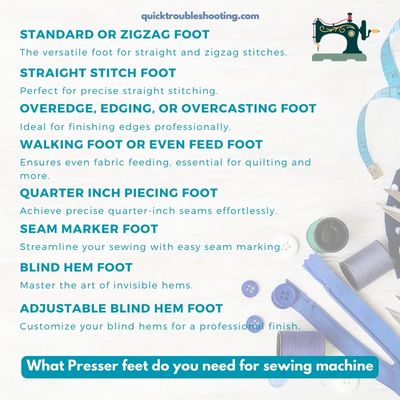
What Presser feet do you need for sewing machine:
- Standard or Zigzag Foot: The versatile foot for straight and zigzag stitches.
- Straight Stitch Foot: Perfect for precise straight stitching.
- Overedge, Edging, or Overcasting Foot: Ideal for finishing edges professionally.
- Walking Foot or Even Feed Foot: Ensures even fabric feeding, essential for quilting and more.
- Quarter Inch Piecing Foot: Achieve precise quarter-inch seams effortlessly.
- Seam Marker Foot: Streamline your sewing with easy seam marking.
- Blind Hem Foot: Master the art of invisible hems.
- Adjustable Blind Hem Foot: Customize your blind hems for a professional finish.
Dive into this guide to not only explore the must-have Presser feet for regular use but also uncover lesser-known sewing machine feet designed for specialty purposes. Discover how each sewing machine foot can elevate your sewing projects, and find answers to common questions like, “What is the most common sewing foot?” Unleash your sewing machine’s potential with this valuable resource.
Sewing Machine Feet Guide Tutorial
Embarking on a sewing project? Don’t overlook the array of sewing machine feet that came with your machine—they’re more than just accessories. Delving into the world of sewing machine feet can significantly enhance the quality of your projects. Let’s explore why and how in this comprehensive guide tutorial.
1. Importance of Choosing the Right Foot
Have you ever wondered how a seemingly simple sewing project can turn into a professional-looking masterpiece? The secret often lies in selecting the right sewing machine foot. Taking a little extra time to match the correct foot and needle to your project can elevate the overall appearance and quality of your work. This tutorial will guide you through various types of sewing machine feet, helping you make informed choices for different tasks.
2. Types of Sewing Machine Feet: Snap-On vs. Screw-On
Understanding the mechanism of attaching sewing machine feet is crucial. The two primary methods are snap-on and screw-on, with the choice depending on your machine’s brand.
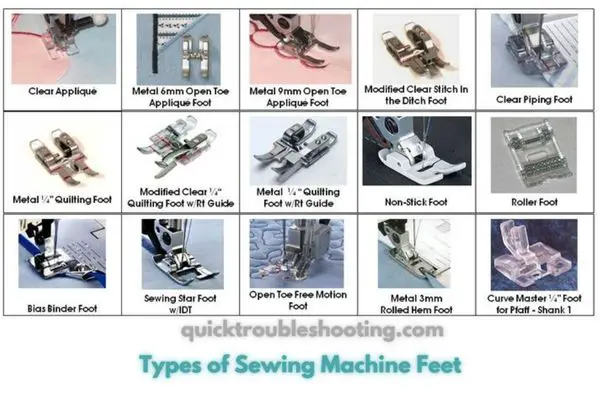
Snap-On Method: Fast and Efficient
Most modern machines utilize the snap-on method, offering a quick and efficient way to change feet. The process is seamless and takes just a moment, allowing you to transition between feet effortlessly. We’ll walk you through the steps of using snap-on feet, ensuring you make the most of this convenient feature.
Screw-On Method: Classic and Reliable
On the other hand, older machines often feature screw-on feet, which are attached using a large screw. While this method may take a few extra seconds, it remains straightforward and user-friendly. We’ll provide detailed instructions on how to confidently switch between screw-on feet, ensuring you feel comfortable and in control.
Intrigued to learn more? Let’s delve into the intricate details of sewing machine feet in this comprehensive tutorial. Your sewing projects are about to reach new heights!
What Are The Different Sewing Machine Feet?
Sewing machine feet are indispensable tools that can elevate your sewing projects, providing specialized functions for different tasks.
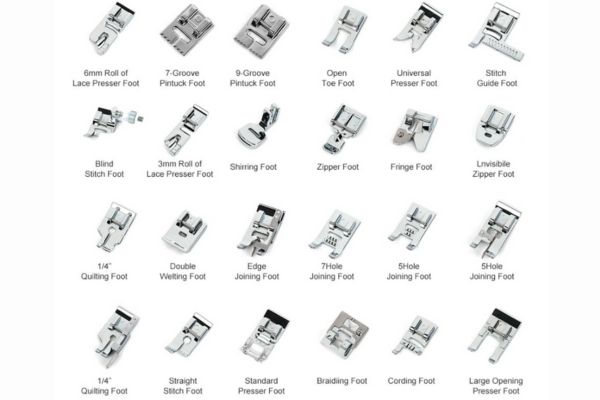
Whether you’re a beginner or an experienced sewist, understanding the variety of sewing machine feet available can significantly enhance your sewing capabilities. Here’s an in-depth exploration of the different types:
1. All-Purpose Presser Foot (Universal Foot)
- Function: Beyond straight stitching and decorative stitches, this foot handles simple zig-zag on a wide variety of fabrics.
- Aliases: General purpose foot, straight stitching foot, standard foot, multi-purpose foot.
- Importance: A versatile workhorse, pivotal for 90% of sewing projects; a must-have for beginners and seasoned sewists alike.
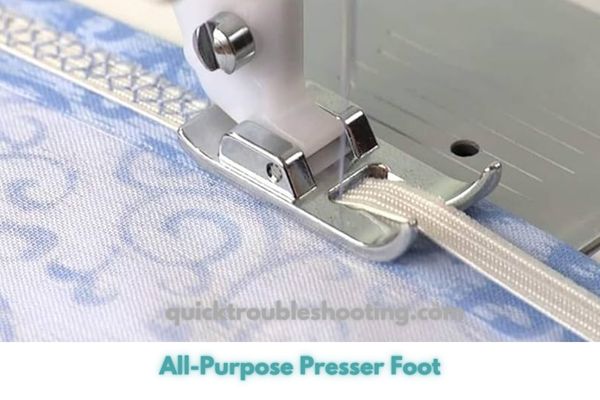
Articles on the topic: A Comprehensive Guide to the All Purpose Sewing Foot Decorative Machine Stitches: Examples & Tips Straight Stitch Foot - Perfect Straight Stitching
2. Rolled Hemming Foot
- Function: Perfect for creating a narrow rolled hem on fine and sheer fabrics.
- Useful Feature: The curved front edge facilitates a seamless hemming process.
- Sizes: Commonly available in ⅛ inch (3mm) and ¼ inch (6mm), offering flexibility for different projects.
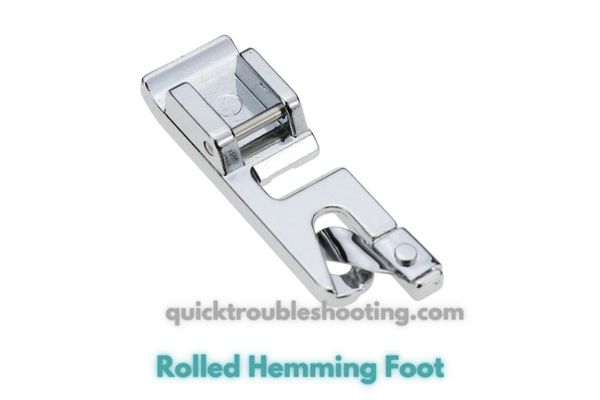
3. Zipper Sewing Machine Foot
- Function: Enables precise sewing close to zipper teeth, piping, and bulky edges.
- Adjustability: Allows needle positioning to the left or right, providing control over stitch placement.
- Tip: While basics work well, specialty feet for invisible zippers are available for those seeking advanced options.
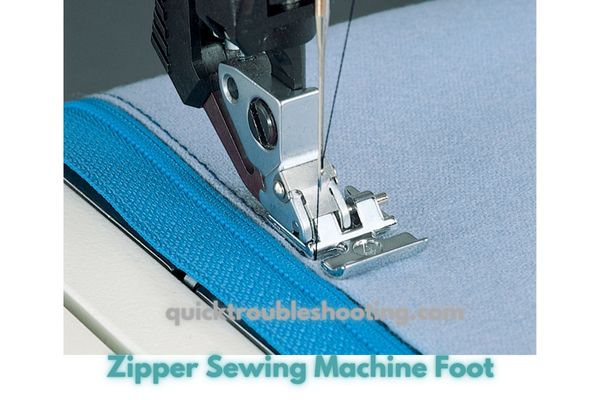
4. Overlock (Overedge or Overcast) Foot
- Function: Creates a professional overlocked edge for knits and wovens.
- Difference from Serger: Unlike a serger, it doesn’t cut the raw edge; trimming before sewing is essential for preventing fraying.
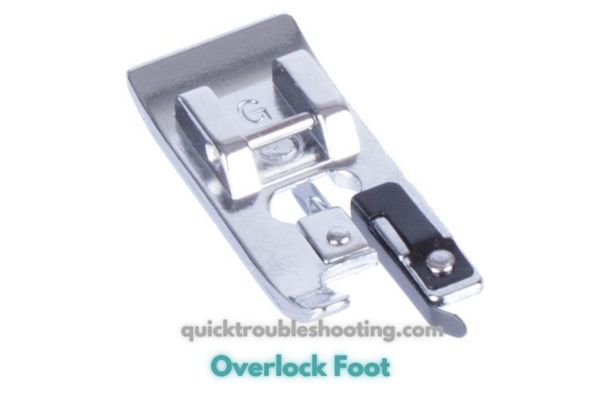
5. Blind-Hem Foot
- Special Feature: Equipped with a metal guide for precise stitching in invisible blind hems.
- Application: Ideal for achieving flawless, nearly invisible hems on a variety of fabrics.
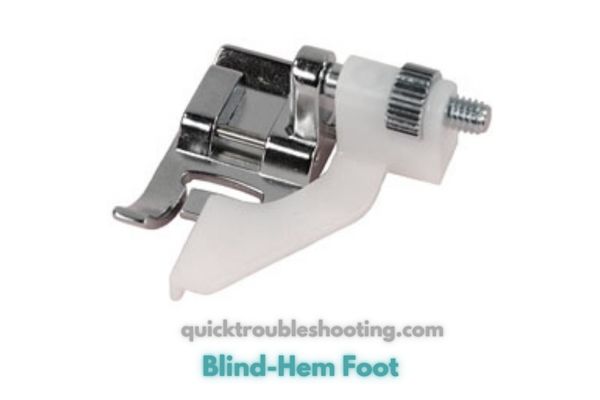
6. Teflon Presser Foot (Non-Stick Foot)
- Advantage: Glides effortlessly over challenging materials like leather and vinyl without sticking.
- Usage: Particularly useful for sewing difficult fabrics like Lycra, also suitable for regular sewing.
- Durability: Made of a plastic-like substance, it may wear out over time and should be replaced periodically.
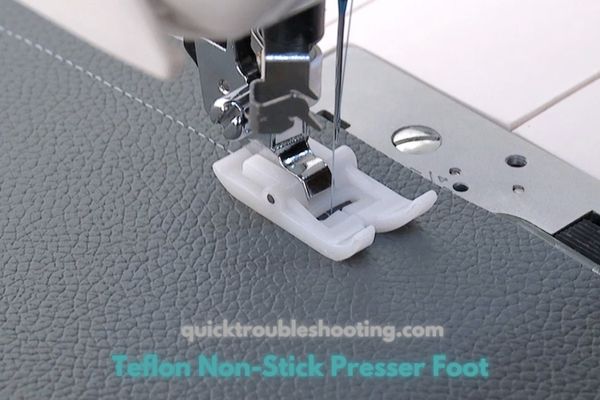
7. Gathering Foot
- Function: Gathers lightweight fabrics as you sew; capable of gathering and joining fabrics simultaneously.
- Fabric Compatibility: Best suited for light or thin fabrics, creating gentle gathers.
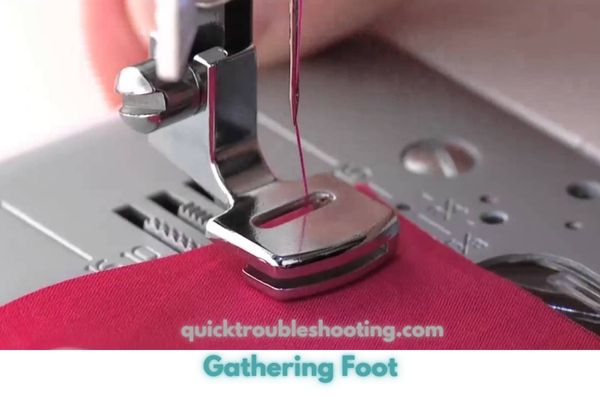
8. Buttonhole Foot
- Purpose: Creates smooth and perfectly sized buttonholes.
- Variation: Appearance may differ across brands; the long white buttonhole foot in some machines automatically sews to the correct length based on the button size.
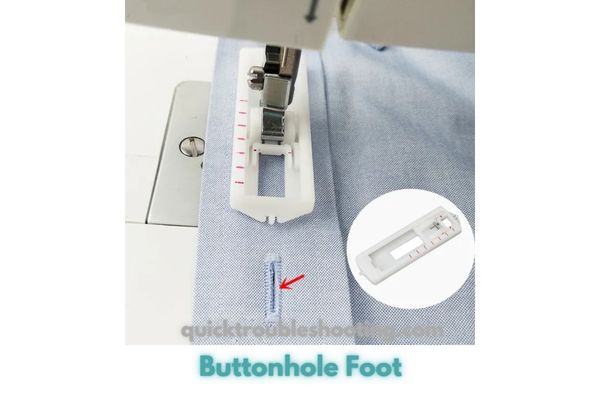
9. Quarter Inch Foot
- Seam Allowance: Provides a precise ¼ inch (6mm) seam allowance.
- Guide Option: Available with or without an extra guide on the side, making it excellent for topstitching flaps on bags and clutches.
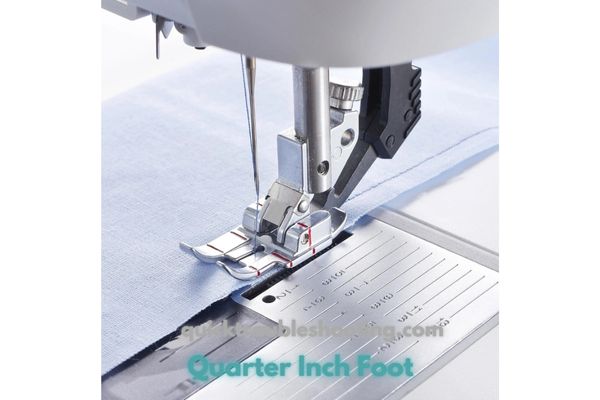
10. Ruffler Foot
- Versatility: An intricate tool for pleating and gathering various fabrics; simultaneously ruffles and stitches.
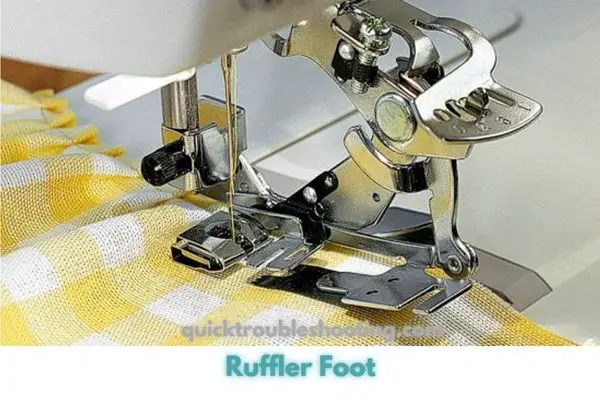
11. Walking Foot
- Usefulness: Essential for quilting, leather, and lycra; prevents sticking and puckering in multiple fabric layers.
- Mechanism: The up-and-down movement ensures even feeding of fabric layers through the feed dogs.
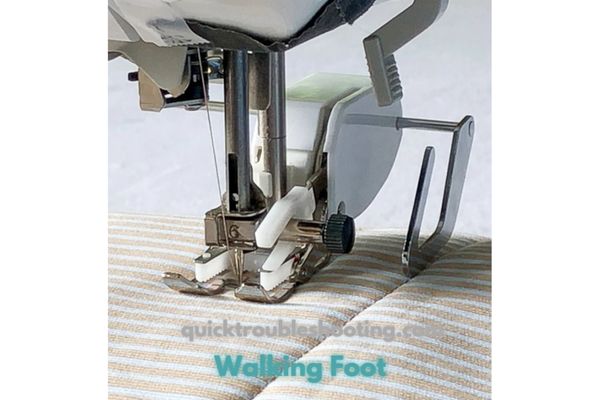
12. Binder Foot
- Application: Attaches bias tape (bias binding) to raw edges; best suited for straight edges.
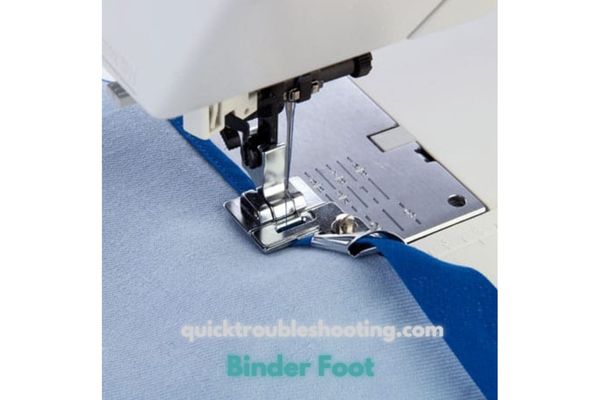
13. Edge Stitch Foot
- Feature: Equipped with a guide for accurate stitching in the crease of seams; invaluable for quilting projects.
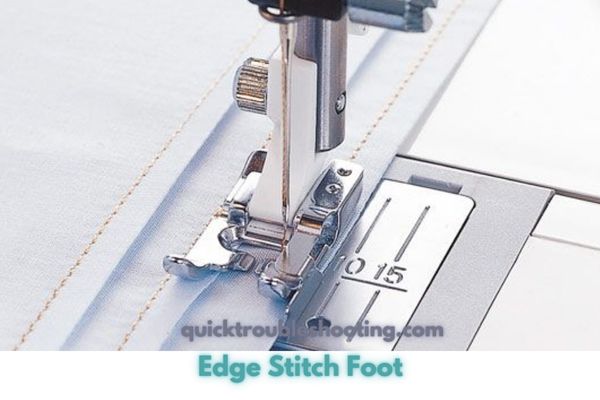
14. Roller Foot
- Design: Features a rolling bar in the front and back, enabling smooth gliding over leather and vinyl surfaces.
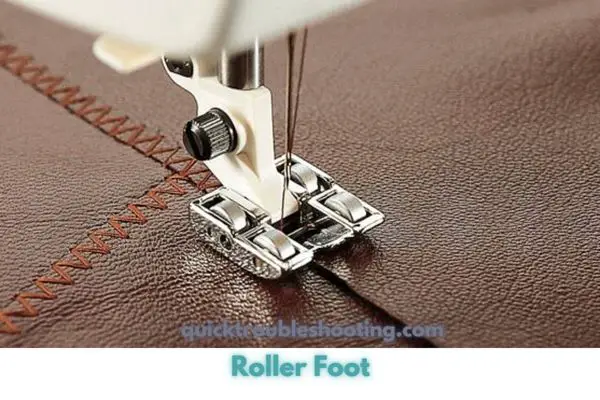
15. Darning Foot (Free Motion or Embroidery Foot)
- Use: A versatile foot for repairing rips and facilitating free motion quilting.
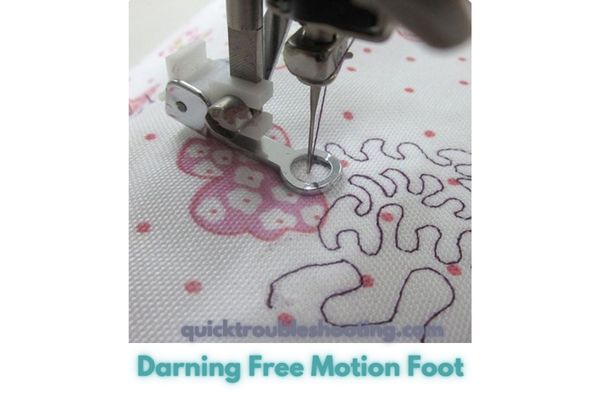
16. Zig-Zag Foot
- Alias: Another term for the all-purpose sewing machine foot; accommodates both zig-zag and straight stitching with its wide toe.
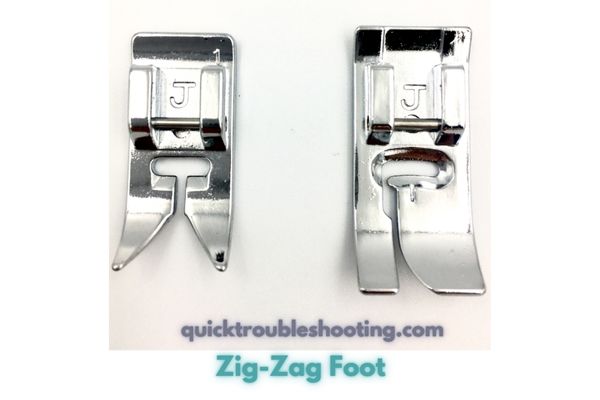
17. Pin Tuck Sewing Machine Foot
- Design: Grooves on the back of the foot space tucks, used in conjunction with a twin needle for evenly spaced pin tucks.
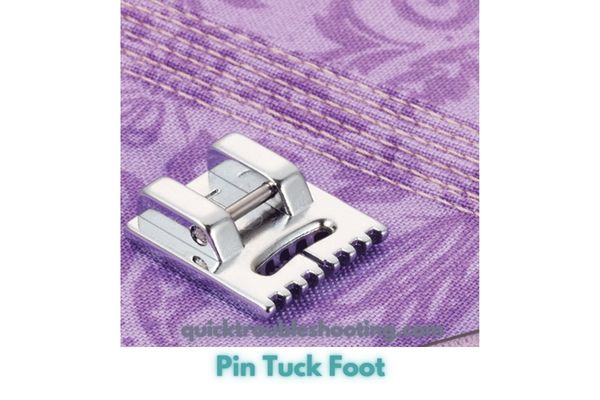
18. Invisible Zipper Foot
- Advantage: Enables closer sewing to zipper teeth for a virtually invisible finish.
- Design Feature: Features a groove on the underside that slides over the zipper teeth with precision.
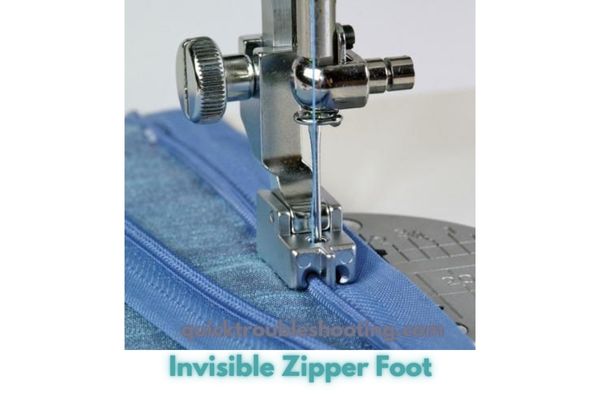
Explore this diverse world of sewing machine feet to unlock the full potential of your sewing projects. Each foot is a specialized tool designed to address specific challenges and enhance the precision and efficiency of your sewing endeavors.
Sewing Machine Feet Chart
| Sewing Machine Foot | Function | Aliases | Importance |
|---|---|---|---|
| 1. All-Purpose Presser Foot (Universal Foot) | – Handles straight stitching, decorative stitches, and simple zig-zag on various fabrics. | General purpose foot, straight stitching foot, standard foot, multi-purpose foot. | Essential for 90% of sewing projects; a versatile workhorse for all levels of sewists. |
| 2. Rolled Hemming Foot | – Creates a narrow rolled hem on fine and sheer fabrics. | – Curved front edge for seamless hemming. | Perfect for achieving a professional finish on hems; available in various size options. |
| 3. Zipper Sewing Machine Foot | – Enables precise sewing close to zipper teeth, piping, and bulky edges. | – Allows needle positioning to the left or right. | Basics work well; specialized feet for invisible zippers are available for advanced options. |
| 4. Overlock (Overedge or Overcast) Foot | – Creates a professional overlocked edge for knits and wovens. | – Does not cut the raw edge; trimming is essential. | Ideal for neat finishes on fabric edges without fraying; differs from a serger in cutting approach. |
| 5. Blind-Hem Foot | – Equipped with a metal guide for precise stitching in invisible blind hems. | – Ideal for achieving nearly invisible hems. | Perfect for creating discreet hems on a variety of fabrics with accuracy. |
| 6. Teflon Presser Foot (Non-Stick Foot) | – Glides effortlessly over challenging materials like leather and vinyl. | – Suitable for sewing difficult fabrics like Lycra. | Ideal for challenging fabrics; periodic replacement may be necessary due to wear. |
| 7. Gathering Foot | – Gathers lightweight fabrics as you sew; capable of gathering and joining fabrics. | – Best for light or thin fabrics, creating gentle gathers. | Efficient for creating gentle gathers on lightweight fabrics with simultaneous joining. |
| 8. Buttonhole Foot | – Creates smooth and perfectly sized buttonholes. | – Appearance may vary across brands. | Essential for crafting precise and polished buttonholes; different appearances in various machines. |
| 9. Quarter Inch Foot | – Provides a precise ¼ inch (6mm) seam allowance. | – Available with or without an extra guide. | Ideal for achieving accurate seam allowances, especially useful for topstitching flaps. |
| 10. Ruffler Foot | – An intricate tool for pleating and gathering various fabrics; simultaneously ruffles and stitches. | – Versatile tool for various fabric manipulations. | Adds decorative elements to fabrics; capable of complex pleating and gathering simultaneously. |
| 11. Walking Foot | – Essential for quilting, leather, and lycra; prevents sticking and puckering in multiple fabric layers. | – Ensures even feeding of fabric layers. | A must-have for quilting and working with challenging fabrics, prevents uneven feeding. |
| 12. Binder Foot | – Attaches bias tape (bias binding) to raw edges; best suited for straight edges. | – Application limited to straight edges. | Ideal for applying bias tape neatly to straight edges, enhancing the finish of projects. |
| 13. Edge Stitch Foot | – Equipped with a guide for accurate stitching in the crease of seams; invaluable for quilting projects. | – Excellent for accurate seam placement. | Precise stitching along seams and edges, especially beneficial for quilting enthusiasts. |
| 14. Roller Foot | – Features a rolling bar in the front and back, enabling smooth gliding over leather and vinyl. | – Designed for gliding over challenging surfaces. | Ideal for working with leather and vinyl, facilitates smooth stitching over uneven surfaces. |
| 15. Darning Foot (Free Motion or Embroidery Foot) | – Versatile foot for repairing rips and facilitating free motion quilting. | – Suitable for various free-motion applications. | Enables intricate stitching for repairs and free-motion quilting; offers creative flexibility. |
| 16. Zig-Zag Foot | – Another term for the all-purpose sewing machine foot; accommodates both zig-zag and straight stitching. | – Wide toe for zig-zag motion. | Versatile foot for both zig-zag and straight stitches, characterized by its wide toe. |
| 17. Pin Tuck Sewing Machine Foot | – Features grooves on the back for creating evenly spaced pin tucks with a twin needle. | – Used in conjunction with a twin needle. | Ideal for crafting precise pin tucks with evenly spaced results, enhancing fabric texture. |
| 18. Invisible Zipper Foot | – Enables closer sewing to zipper teeth for a virtually invisible finish. | – Features a groove on the underside for precise sliding. | Perfect for achieving a seamless, invisible finish when sewing garments with concealed zippers. |
Where To Buy Sewing Machine Feet?
If you’re looking to expand your sewing machine foot collection without breaking the bank, consider purchasing in multi-packs. Not only do these packs offer cost savings, but they are also compatible with most low shank machines, providing versatility and convenience. Investing in a variety of feet can significantly enhance your sewing experience, improving both the quality and productivity of your projects.
1. Multi-Packs for Cost Savings and Compatibility
- Cost-Effective: Purchasing sewing machine feet in multi-packs is a budget-friendly option, allowing you to acquire a variety of feet at a lower overall cost compared to buying individual pieces.
- Compatibility: Multi-packs are designed to fit most low shank machines, offering broad compatibility and making them suitable for a wide range of sewing machines.
2. Generic Kits on Amazon and eBay
- Quality Findings: Surprisingly, generic kits available on popular online platforms such as Amazon and eBay are often of good quality. Many users have found these kits to be reliable and effective for various sewing tasks.
- Affordable Options: The generic kits on these platforms provide an affordable solution for sewists looking to expand their collection without investing in expensive branded accessories.
3. Tips for Shopping Online
- Read Reviews: Before making a purchase, take the time to read reviews from other customers. This can provide insights into the quality and performance of the sewing machine feet in the kit.
- Check Compatibility: Ensure that the multi-pack or kit is compatible with your specific sewing machine model. Look for information regarding shank types to confirm compatibility.
- Labeling and Packaging: While purchasing a multi-pack, be mindful not to discard the labeling and packaging. With a multitude of loose feet, it can be challenging to identify each one. Keeping the original packaging helps in organizing and distinguishing between different feet.
- Compare Prices: Compare prices across different sellers and platforms to ensure you are getting the best deal. Pay attention to any additional features or accessories included in the kit.
4. Consider Local Sewing Supply Stores
- Specialty Stores: Local sewing supply stores may carry multi-packs of sewing machine feet. Visit specialty stores that cater to sewing enthusiasts for personalized advice and recommendations.
- Supporting Local Businesses: Purchasing from local stores supports the community and allows you to seek advice from experienced staff regarding the compatibility and usage of specific sewing machine feet.
Whether opting for online marketplaces like Amazon and eBay or exploring local sewing supply stores, multi-packs offer a cost-effective way to expand your collection and improve the overall quality of your sewing projects. Remember to maintain the labeling and packaging for efficient organization, and read reviews to make informed decisions on the quality of generic kits.
How do you clean sewing machine feet?
Cleaning your sewing machine feet is a simple yet crucial step to ensure optimal performance and maintain the quality of your stitching.
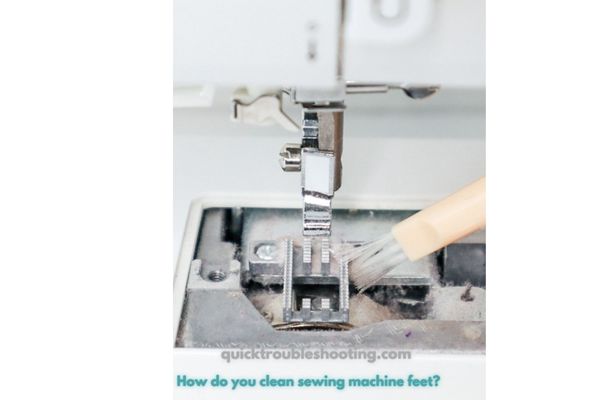
Here’s a detailed guide on how to effectively clean your sewing machine feet:
1.Remove the Feet:
- Start by lifting the presser foot lever to release the presser foot.
- Gently pull the foot down and away from the presser foot holder to detach it from the machine.
2.Use a Small Brush:
- Employ a small, soft brush, like a dedicated sewing machine cleaning brush or a clean, dry paintbrush.
- Brush away any visible lint, dust, or debris from the bottom and sides of the presser foot.
3.Compressed Air for Precision:
- For a more thorough cleaning, use compressed air. Ensure the air pressure is set at a moderate level to avoid damaging delicate components.
- Direct the airflow to remove any remaining particles lodged in crevices and hard-to-reach areas.
4.Damp Cloth for Stubborn Residue:
- If there are stubborn residues or sticky substances on the presser foot, dampen a soft, lint-free cloth with a mild sewing machine oil or a specialized cleaner.
- Gently wipe the affected areas to dissolve and remove the residue. Take care not to saturate the foot.
5.Inspect for Hidden Debris:
- Examine the presser foot closely for any hidden debris or buildup. Pay attention to hinges, joints, and other moving parts.
- Use a fine-pointed tool or the tip of the brush to dislodge any trapped lint.
6.Dry Thoroughly:
- Allow the cleaned presser foot to air-dry completely before reattaching it to the sewing machine.
- Ensure there is no residual moisture that could potentially cause rust or damage.
7.Regular Maintenance Routine:
- Incorporate cleaning your sewing machine feet into your regular maintenance routine. Aim to clean them after each significant sewing project or as needed.
- Keep the brush and other cleaning tools within easy reach to encourage consistent maintenance.
8.Consider Professional Servicing:
- If you encounter persistent issues or notice signs of wear and tear on the presser foot, consider seeking professional servicing from a certified technician.
- Professional maintenance can address more complex issues and extend the lifespan of your sewing machine feet.
By following these detailed steps, you can ensure that your sewing machine feet remain free from lint and debris, contributing to smoother sewing, better stitch quality, and prolonged durability. Regular cleaning not only maintains the functionality of your presser feet but also enhances the overall performance of your sewing machine.
FAQ: Sewing Machine Presser Feet
What is a normal sewing foot? What are standard presser feet?
A normal sewing foot, also known as a standard presser foot, is the default foot that typically comes with most sewing machines. It is versatile, allowing for straight stitches, zigzag stitches, and basic sewing on various fabrics. Standard presser feet are the essential attachments for general sewing tasks.
Do all presser feet fit all sewing machines?
No, not all presser feet fit all sewing machines. Sewing machines come in different shank types – low shank, high shank, and others. It’s crucial to ensure that the presser foot you choose is compatible with your machine’s shank type.
What is the G presser foot used for?
The G presser foot is typically used for sewing decorative stitches. It allows for precise stitching and control, making it suitable for embellishments and intricate sewing projects.
What is the S presser foot used for?
The S presser foot, often called the overcast or overedge foot, is designed for finishing fabric edges, preventing fraying. It creates a neat, professional-looking edge on both woven and knit fabrics.
What is the most common sewing foot? What is the most used presser foot?
The most common and widely used sewing foot is the all-purpose or universal presser foot. It accommodates straight stitching, decorative stitches, and zigzag stitching on a variety of fabrics.
What foot to use for denim?
For sewing denim, it’s recommended to use a denim or jeans presser foot. This foot is designed with a sturdy build to handle the thickness of denim fabrics and typically comes with features like a non-stick coating for smooth sewing.
What is a stitch guide foot?
A stitch guide foot has a guide on its side, allowing for precise seam placement. It’s particularly useful for stitching along seams, edges, or other designated lines, ensuring accuracy in your sewing projects.
What foot do I need for a zigzag stitch?
For a zigzag stitch, you can use the zigzag presser foot or the all-purpose foot. These feet allow the needle to move from side to side, creating zigzag stitches of various widths.
What is the best presser foot for silk?
When sewing silk, it’s recommended to use a walking foot or a Teflon presser foot. These feet provide even feeding of delicate fabrics like silk, preventing slipping and ensuring smooth stitching.
Do I need a walking foot for sewing?
A walking foot is beneficial for sewing multiple layers or slippery fabrics as it feeds layers evenly. While not necessary for every project, it can enhance the quality of quilting, leatherwork, and other challenging tasks.
How do I know if my machine is a low shank or high shank?
Measure the distance from the bottom of the presser foot holder to the needle plate. If it’s around ½ inch, it’s a low shank; if it’s approximately 1 inch, it’s a high shank.
How many types of presser feet are there?
There are numerous types of presser feet, each designed for specific sewing tasks. Common types include standard, zipper, buttonhole, walking, quilting, and overlock feet, among others.
Is it bad to sew without a presser foot? Can you use a sewing machine without a presser foot?
It’s not recommended to sew without a presser foot. The presser foot helps control fabric movement and ensures proper stitching. Attempting to sew without it may result in uneven stitches and fabric misalignment.
What stitch to use with an overlock foot?
The overlock foot is typically used with an overlock or serger stitch. It trims the fabric edge and encases it in thread, preventing fraying and providing a professional finish.
Are all sewing machine feet compatible?
Not all sewing machine feet are compatible with every machine. Compatibility depends on the machine’s shank type, so it’s essential to check and choose feet accordingly.
What Does A Presser Foot Do?
A presser foot holds the fabric in place while stitching, ensuring even feeding and preventing fabric distortion. It also helps maintain a consistent stitch length and alignment, contributing to the overall quality of the sewing project.
Conclusion: All The Presser Feet You Need
In conclusion, this comprehensive guide to sewing machine feet provides a valuable resource for both novice and experienced seamstresses. Covering an array of presser feet, from the essential to the specialized, it empowers users to enhance the speed, accuracy, and ease of their sewing projects.
Whether you’re exploring standard feet like the zigzag or venturing into the realm of unique attachments, this guide ensures you have the knowledge to choose the right tool for every sewing endeavor. With tips on maintenance and cleaning, it’s a go-to reference for optimizing the performance and longevity of your sewing machine feet. Elevate your sewing experience by unlocking the potential of these versatile tools.
